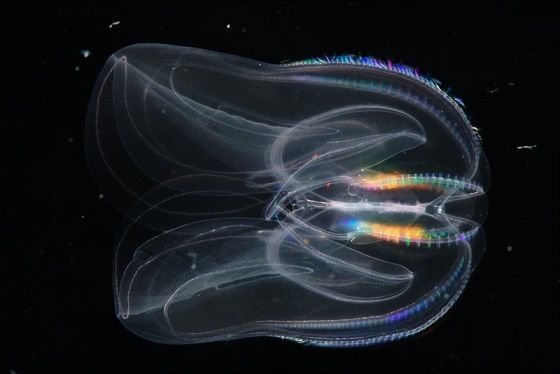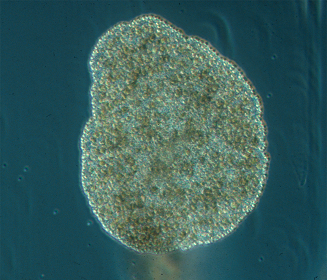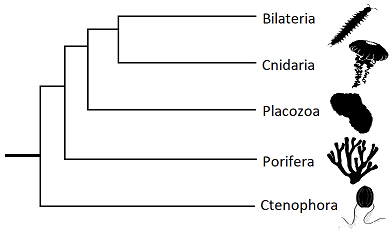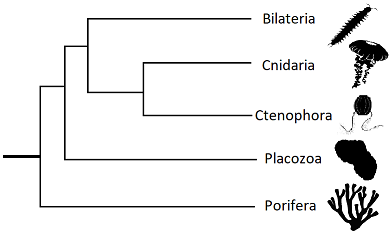Have you ever wondered, how the very first animals came to be and which we are closest related to? The evolution of most modern species is quite well understood, but there is still much debate on the evolution of the earliest animal species.
Originally, it was believed, that the sponges, also known as porifera, were the earliest branching animal group, making them sister to all other animals. These assumptions based of the observation, that porifera lack many complex traits other animals show, like muscles, neurons, synapses or a gut. Recently though, phylogenetic research lead to the idea, that comb jellies may actually be the sister to all other animals.

The comb jelly Mnemiopsis leidyi, also known as sea walnut (5)
As it is very difficult to accurately retrace evolutionary developments in animal lineages this old, there are still many uncertainties. Today, mainly two models concur against each other. One being the porifera-sister hypothesis and the other being the ctenophora-sister hypothesis.
Nathan V. Whelan, a researcher currently working at the US Fish and Wildlife Service(3), tried to clarify this situation in 2015. He and his team looked at a comprehensive data set containing the genome of some of the oldest known animal groups. The groups Whelan chose for his analysis were the aforementioned comb jellies and sponges. The cnidaria, to which most of the commonly known jellyfish count and the bilateria, who include the first animals animals to have a fore and a behind, were included as well.
Additionally, the somewhat novel discovered placozoa were also included. Placozoa are primitively built animals, that only have two cell layers with an intermediate layer. Scientists believe that some of the very first animal like lifeforms might have looked and lived like Placozoa.

Trichoplax adhaerens is, to date, the only known placozoa (5)
Whelans analysis yielded the comb jellies to be the sister to all other animals with the placozoa branching of after the sponges but before cnidaria and bilateria.
This implies, that complex animal traits, like neurons, muscles or a gut, were either lost in sponges and placozoa together or developed twice independently, once during the evolution of the comb jellies and once during the evolution of bilateria and cnidaria. Phenomena like this, where similar traits develop twice in different species, are called convergent evolution. Other examples of convergent evolution are bat and bird wings, which look similar and have similar functions, but do not stem from a common ancestor.
With his study, Whelan et al. delivered a strong argument for the ctenophora-sister hypothesis in the debate for the early animal evolution.

The phylogenetic tree according to the Ctenophora sister hypothesis.
However, just least year the debate took another shift as Paul Simion, a researcher currently working at the Institut de Sciences de l'Évolution Montpellier (4), and his team conducted an in depth analysis on the same groups as Whelans team.
They recovered the porifera as sister to all other animals, with the placozoa branching off after the comb jellies and before the bilateria and the cnidaria. This poses a return to the old belief of the porifera-sister theory.

The phylogenetic tree according to the Porifera sister hypothesis.
The propositions made in Simions Paper are backed up by the size of their dataset. It is bigger than that of all previous studies, containing 1719 genes with more than 20 million amino acids in molecular information. This outperforms Whelans dataset several times over.
Simion and his Team believe previous results, differing from theirs might have been caused by a phenomenon called long branch attraction, during which distant, unrelated species seem to be more closely related than they actually are. The causes of this can often be linked to convergent evolution and occurs, when the branches undergo a lot of change.
With Simions study rejecting the ctenophora-sister hypothesis, the absence of higher animal features, like a nervous system, in Sponges can now be seen as ancestral. This is a return to the old views, according to which these features weren’t lost in sponges, but they never had them to begin with.

Several species of sponge, prominently the yellow tube sponge(Aplysina fistularis) (6)
This, however still leaves the question of how these higher features came to be. Either, ctenophora developed their higher features independently to bilateria and cnidiara, meaning they are convergent features. Or the placozoa lost them along the way, if comb jellies, cnidaria and bilateria share their gut, neurons, synapses and muscles over a common ancestor, making these features homologous.
The idea of converging features is supported by the plethora of unique features in the comb jellies like their combs, and their unique nervous system. The placozoan loss idea is supported by their genome. It has traits that would be typical for higher animals, like bilateria. Placozoa also produce proteins associated with Neurons, which hints at their ancestors once having possessed nerve cells.
The question, whether the nervous system of comb jellies and that of cnidaria/bilateria is convergent or homologous remains open to debate. Going forward, we can expect more findings to illuminate the mysteries of early animal evolution.
Images:
The images used have been labelled for re use by wikipedia or wikimedia.
The phylogenetic trees were created with drawings taken from http://phylopic.org/
Sources:
(1) Whelan NV, Kocot KM, Moroz LLc, Halanych KM (2015) Error, signal, and the placement of Ctenophora sister to all other animals PNAS 112, 5773-5778.
(2) Simion P et al. (2017) A Large and Consistent Phylogenomic Dataset Supports Sponges as the Sister Group to All Other Animals CurrBiol 27, 958-967
(3) http://nathanwhelan.com/assests/Whelan_CV_website.pdf
(4) https://www.researchgate.net/profile/Paul_Simion
(5) https://commons.wikimedia.org/
(6) https://en.wikipedia.org/wiki/Sponge
These are the questions that keep me up at night!
Great post :)
Glad you like it!
Evolution is indeed very amazing and interesting and what I wrote here is just the smallest fraction of it.
There is so much more!
Haha yes, I remember learning both the animal and plant phylogenies in undergrad.... such fun times :p
Congratulations @spaceshroom! You received a personal award!
Click here to view your Board
Congratulations @spaceshroom! You received a personal award!
You can view your badges on your Steem Board and compare to others on the Steem Ranking
Vote for @Steemitboard as a witness to get one more award and increased upvotes!